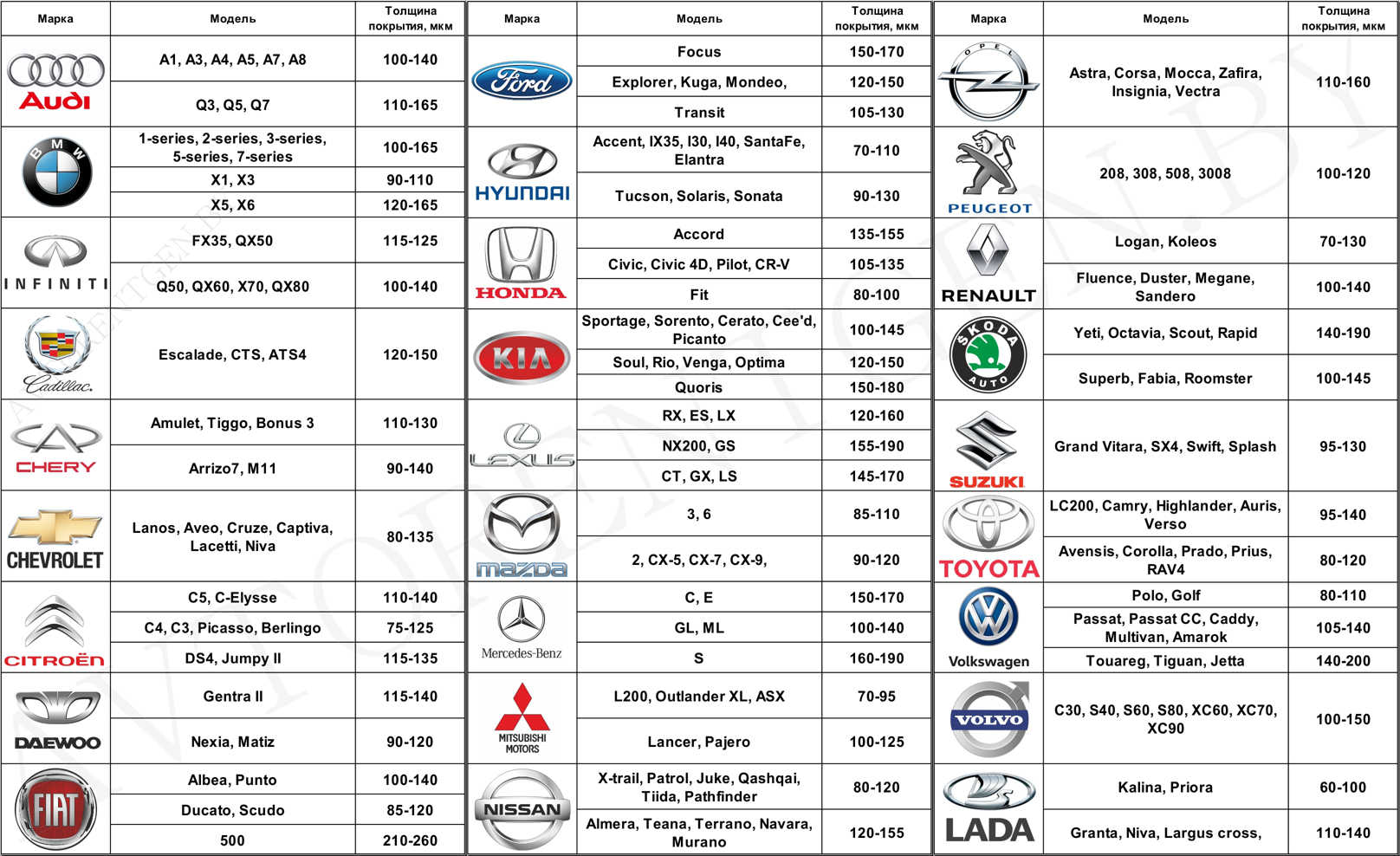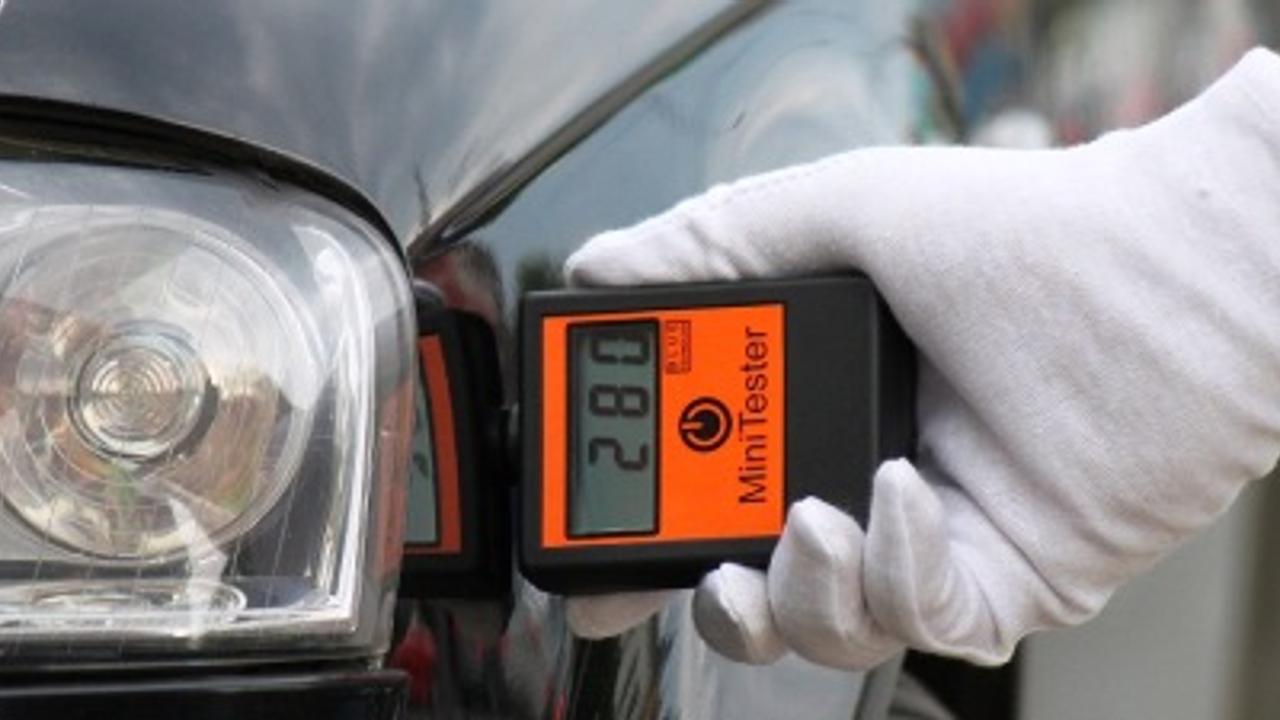
Table of paintwork thickness on cars from the factory and after repair
Content
The height of the layer is measured by 4-5 points in the center and along the edges of the area under study. Usually the difference between adjacent parts should not exceed 30-40 microns. LPC is measured on an aluminum surface with a thickness gauge calibrated for this metal. To determine the height of the paint layer on plastic, you cannot use a magnetic device. To do this, use an ultrasonic measuring device or visually check the color deviations.
The ideal condition of the paint on the old car naturally arouses suspicion. Check the thickness of the paintwork on cars according to the table for a specific model. Deviations from the standard values are most likely related to the body repair carried out.
Determination of car paint thickness
Usually, when buying a used car, in addition to external inspection, they check the paintwork. Too high coverage is likely to indicate a body repair. How many layers of paint are applied depends on the model of car and the type of paintwork.
Methods for determining the height of the coating on the car body:
- A permanent magnet that is only normally attracted to a metal surface with a thin layer of enamel and varnish.
- Revealing, under good lighting, differences in the shades of the paint layer of adjacent sections on the car body.
- An electronic thickness gauge that helps to measure the paintwork of a car with high accuracy.
Devices for determining the proper amount of paint on the surface of the body are also mechanical, ultrasonic and laser. Compare the thickness of the paintwork on cars according to the table of standard values for a particular model.
Which items to check first
In different parts of the car body, the height of the paint layer is slightly different. When measuring, it is necessary to compare the obtained result with the standard one from the table.

Evaluation of LCP on car bodies
Machine body parts differ in design and surface dimensions. In the event of an accident, damage is essentially more frontal parts of the car.
The sequence of parts for which the thickness of the paintwork is determined:
- roof;
- racks;
- hood;
- trunk;
- doors;
- thresholds;
- side pads;
- internal painted surfaces.
The height of the layer is measured by 4-5 points in the center and along the edges of the area under study. Usually the difference between adjacent parts should not exceed 30-40 microns. LPC is measured on an aluminum surface with a thickness gauge calibrated for this metal.
To determine the height of the paint layer on plastic, you cannot use a magnetic device. To do this, use an ultrasonic measuring device or visually check the color deviations.
Paint thickness table
Car manufacturers paint the body with primer, enamel and varnish with different properties. The normal layer can vary in height, but most values fall in the 80-170 micron range. The thickness tables of the paintwork of cars of different parts of the body are shown by the manufacturers themselves.
A value of more than 200 microns usually indicates re-painting, and more than 300 microns - a likely putty of a broken car body. Good to know that premium car models have paint thicknesses up to 250 microns.
Car paintwork in comparison
A small layer of coating is more likely to be damaged and can fly off even when washing under pressure. The strength of the protection of metal surfaces of the body is also affected by the properties of the materials. But the determining indicator of the quality of car painting is the thickness of the coating.
Usually, to save money, the manufacturer reduces the height of application on automotive parts that are not exposed to harmful effects. The paint on the roof, interior surfaces and trunk is usually thinner. In domestic and Japanese cars, the thickness of the paintwork is 60-120 microns, and in most European and American brands it is 100-180 microns.
What values indicate additional layers
Local body repairs are usually done without completely removing the paint. Therefore, the height of the new coating is greater than the original applied on the conveyor. The thickness of the layer of enamel and putty after repair is often higher than 0,2-0,3 mm. Also at the factory, a layer of paint is applied evenly; a height difference of about 20-40 microns is considered acceptable. With high-quality body repair, the paint may be the same thickness as the original. But differences in the height of the coating reach 40-50% or more.
What indicates interference
A wrecked car after restoration of the body may look like a new one. But checking with a magnet or measuring device should easily reveal traces of tampering.
Signs of body repair and repainting:
- the difference in the thickness of the paintwork on cars from the table of standard values by 50-150 microns;
- coating height differences on one part more than 40 micrometers;
- local differences in the shade of color on the surface of the body;
- painted fasteners;
- dust and small inclusions in the varnish layer.
When measuring, it is also necessary to take into account the range of deviations in the table for a specific model.
The reason for the thin paintwork of modern cars
Most car manufacturers try to save on everything in order to lower the price and beat the competition. Reducing the height of the paintwork on non-critical body parts is one way to reduce costs. Therefore, if the factory paint layer on the hood and doors is usually 80-160 microns, then on the internal surfaces and the roof - only 40-100 microns. More often, such a difference in coating thickness is found in domestic, Japanese and Korean cars.

The principle of operation of the thickness gauge
This measure is justified, since the inner and upper surfaces of the body are less in contact with road dust and reagents than low-lying ones. A small level of paint is applied using high-quality durable materials. The improved composition of the enamel with a high pigment density allows to reduce the number of layers of painting.
Another reason for thin car body paintwork is the environmental requirements that automakers must comply with.